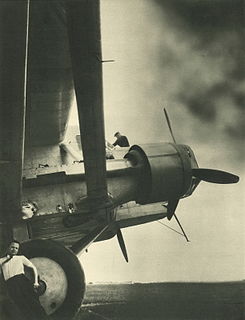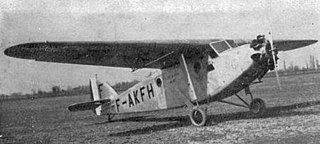
The Latécoère 28 was a successful French long-haul mail plane and passenger airliner of the 1930s. It was the main-stay of Air France's predecessor, Aéropostale in its efforts to establish intercontinental air mail services and support French colonialism and French cultural influence between the wars.

The Farman F.220 and its derivatives were thick-sectioned, high-winged, four engined monoplanes from Farman Aviation Works. Based on the push-pull configuration proven by the F.211, design started in August 1925 and the first flight of the prototype was on 26 May 1932. The definitive F.222 variant was the biggest bomber to serve in France between the world wars. One variant was designed as an airliner.

The Farman F.60 Goliath was a French airliner and bomber produced by the Farman Aviation Works from 1919. It was instrumental in the creation of early airlines and commercial routes in Europe after World War I.

The Dewoitine D.338 was a 1930s French 22-passenger airliner built by Dewoitine.

The Farman F.430 was a 1930s French light transport designed and built by the Farman Aviation Works. Two variants with different engines were known as the F.431 and F.432.

The Farman F.300 and F.310 were airliners built in France in the early 1930s. They were high-wing strut braced monoplanes with fixed tailskid undercarriage with a trimotor layout popular with several manufacturers of the time. The cockpit and passenger compartment were fully enclosed. Most saw service in Farman's own airline, whose twelve F.300 variants made up half its fleet in 1931.

The Latécoère 26 was a French monoplane mail plane designed and built by Latécoère.
The Latécoère 14 and Latécoère 16 were similar French passenger and postal aircraft of advanced design built in 1923. They differed chiefly in engine power. Only one of each was constructed. The 14's type number was reused for an unrelated parasol wing prototype that was basis of the more successful Latécoère 17.

The Latécoère 17 was a French airliner built in 1923 for use on Latécoère's own airline routes between France and Morocco. The prototype was designated the Latécoère 14, reusing the number of an unrelated earlier design that had been rejected. This new aircraft was a parasol wing monoplane of conventional configuration with an enclosed cabin for four passengers and an open cockpit for the pilot. This was Latécoère's first commercially successful design and as production continued, three different engines were fitted.

The Latécoère 21 was a French flying boat built in 1925 for use by Lignes Aériennes Latécoère as an airliner on routes between France and North Africa. It was the first of the Latécoère flying boats, and the first aircraft to deliver mail between Marseilles and Algiers. It was a conventional design for the era, with a monoplane wing mounted parasol-fashion. Warren truss-style struts braced the wing to stub wings that acted as sponsons for stability while on the water. The twin engines were placed in tandem push-pull configuration on the wing. Up to seven passengers could be seated in an enclosed cabin, and two pilots sat side by side in separate open cockpits.

The Farman NC.470 was a French twin-engined floatplane designed as a crew trainer for the French Navy. It was used in small numbers for both its intended role as a trainer and as a coastal reconnaissance aircraft at the start of World War II.

The SPCA 80 was a French transport monoplane designed by Société Provençale de Constructions Aéronautiques (SPCA) to meet a French government requirement for a single-engined colonial transport, specifically for police duties. It was a single-engined high-wing cantilever monoplane with a fixed tailskid landing gear. It had a cockpit for a crew of two and a cabin for four passengers. It was powered by a nose-mounted Gnome-Rhône 7Kb radial engine. Only a single example was built, registration F-AKFH.
The Farman F.80 was a 1920s French biplane designed by Farman as a basic trainer.

The Farman F.110 was a French two-seat artillery observation biplane designed and built by the Farman Aviation Works.
The Latécoère 582 was a 1930s French long-range patrol flying-boat designed and built by Latécoère for the French Navy. First flown on 25 July 1935 the 583 was a parasol-wing monoplane flying-boat. Powered by three 890 hp (663 kW) Gnome-Rhône 14Kirs radial piston engines. The French Navy choose to buy the Breguet Bizerte and the one Latécoère 582 ended up as a flying test bed at Saint-Raphaël.

The Farman F.211 was a French four-seat day or night bomber designed and built by the Farman Aviation Works for the French Air Force.
The Farman F.270 was a prototype French bomber/torpedo-bomber designed and built by the Farman Aviation Works for the French Air Force.

The ANF Les Mureaux 120 was a 1930s French three-seat military night reconnaissance monoplane built by ANF Les Mureaux.

The Bréguet 890 Mercure was a late 1940s French cargo and passenger transport aircraft designed by Bréguet Aviation. Three variants were produced including a military variant called the Mars but none entered production.

The Blériot 111 was a French four-seat executive transport monoplane designed by André Herbemont. The first French aircraft to be fitted with a retractable landing gear, after six years development it was not ordered into production.

















